外周血栓延伸与经皮髂股深静脉血栓切除术患者DVT复发风险增加相关。
IF 2.8
2区 医学
Q2 PERIPHERAL VASCULAR DISEASE
Journal of vascular surgery. Venous and lymphatic disorders
Pub Date : 2025-06-06
DOI:10.1016/j.jvsv.2025.102277
引用次数: 0
摘要
目的:髂股深静脉血栓形成(DVT)的患者经常接受经皮血栓切除术,以预防血栓后综合征(PTS)。然而,深静脉血栓程度与取栓后预后之间的关系尚未探讨。本研究的目的是比较孤立性髂股深静脉血栓切除术后DVT复发率和髂股深静脉血栓并向外延伸的患者。方法:我们对2014-2023年接受髂股深静脉血栓切除术的所有患者进行了单中心回顾性分析。患者被分为两组:(1)髂股DVT不伴腘/胫骨延伸;(2)髂股DVT伴腘/胫骨延伸。主要结果是急性深静脉血栓复发,并进行多变量分析以确定复发的危险因素。对分类数据和连续数据分别进行卡方检验和t检验。Kaplan-Meier分析比较急性深静脉血栓形成和术后慢性静脉改变的发生率。p值结果:222例患者在研究期间被确定(76例孤立性髂股DVT vs 146例伴外周延伸的髂股DVT),中位随访时间为19个月。髂股深静脉血栓伴外周延伸的患者年龄较大(57岁vs. 50岁,p=0.004),有高血压(64% vs. 41%, p=0.001)或高脂血症(58% vs. 40%, p=0.01),且在前6个月内接受过手术(29% vs. 17%, p=0.04)。在女性患者中,接受激素治疗的患者更有可能发生孤立性髂股深静脉血栓(17% vs. 3%)。结论:髂股深静脉血栓切除术患者中,更广泛的外周血栓负担与更高的随访DVT复发率相关。这些发现提示此类患者可能需要更密切的随访和更积极的术后抗凝治疗。此外,我们的研究结果为进一步研究外周血栓在静脉血流动力学和复发性深静脉血栓的发展以及最终的PTS中可能发挥的作用提供了一个框架。本文章由计算机程序翻译,如有差异,请以英文原文为准。
Peripheral thrombus extension is associated with increased risk of recurrent deep venous thrombosis in patients undergoing percutaneous thrombectomy for iliofemoral deep venous thrombosis
Objective
Patients presenting with iliofemoral deep venous thrombosis (DVT) often undergo percutaneous thrombectomy intending to prevent post-thrombotic syndrome. However, the relationship between the extent of DVT and outcomes after thrombectomy has not been explored. The objective of this study was to compare rates of post-thrombectomy DVT recurrence between patients with isolated iliofemoral DVT and patients with iliofemoral DVT and extension more peripherally.
Methods
We conducted a single-center, retrospective analysis of all patients who underwent thrombectomy for iliofemoral DVT from 2014 to 2023. Patients were stratified into two cohorts: (1) iliofemoral DVT without popliteal/tibial extension or (2) iliofemoral DVT with popliteal/tibial extension. The primary outcome was acute DVT recurrence and multivariable analysis was performed to identify risk factors for recurrence. The χ2 test and t test were calculated for categorical and continuous data, respectively. Kaplan-Meier analysis was used to compare rates of acute DVT and chronic venous changes postoperatively. A P value of <.05 was considered statistically significant.
Results
We identified 222 patients during the study period (76 isolated iliofemoral DVT vs 146 iliofemoral DVT with peripheral extension) with a median follow-up of 19 months. Patients who presented with iliofemoral DVT with peripheral extension were more likely to be older (57 years vs 50 years; P = .004), have hypertension (64% vs 41%; P = .001) or hyperlipidemia (58% vs 40%; P = .01), and to have had surgery within the prior 6 months (29% vs 17%; P = .04). Among the female patients, those on hormone therapy were more likely to have isolated iliofemoral DVT (17% vs 3%; P < .001). Patients with iliofemoral DVT with peripheral extension had a greater chance of developing recurrent acute DVT (48% vs 20%; P < .001) and chronic venous changes (51% vs 30%; P = .004) during follow-up. Multivariable analysis showed a significant correlation between iliofemoral DVT with peripheral extension (odds ratio, 3.8; 95% confidence interval, 1.7-8.7; P = .001) and acute DVT recurrence. There were no differences in the rates of reintervention or death.
Conclusions
A more extensive peripheral thrombus burden was associated with higher rates of follow-up DVT recurrence in patients undergoing thrombectomy for iliofemoral DVT. These findings suggest that such patients may require closer follow-up and more aggressive anticoagulation therapy postoperatively. Moreover, our results provide a framework for further studies to specifically study the role peripheral thrombus may play in venous hemodynamics and the development of recurrent DVT and, ultimately, post-thrombotic syndrome.
求助全文
通过发布文献求助,成功后即可免费获取论文全文。
去求助
来源期刊

Journal of vascular surgery. Venous and lymphatic disorders
SURGERYPERIPHERAL VASCULAR DISEASE&n-PERIPHERAL VASCULAR DISEASE
CiteScore
6.30
自引率
18.80%
发文量
328
审稿时长
71 days
期刊介绍:
Journal of Vascular Surgery: Venous and Lymphatic Disorders is one of a series of specialist journals launched by the Journal of Vascular Surgery. It aims to be the premier international Journal of medical, endovascular and surgical management of venous and lymphatic disorders. It publishes high quality clinical, research, case reports, techniques, and practice manuscripts related to all aspects of venous and lymphatic disorders, including malformations and wound care, with an emphasis on the practicing clinician. The journal seeks to provide novel and timely information to vascular surgeons, interventionalists, phlebologists, wound care specialists, and allied health professionals who treat patients presenting with vascular and lymphatic disorders. As the official publication of The Society for Vascular Surgery and the American Venous Forum, the Journal will publish, after peer review, selected papers presented at the annual meeting of these organizations and affiliated vascular societies, as well as original articles from members and non-members.
 求助内容:
求助内容: 应助结果提醒方式:
应助结果提醒方式:


